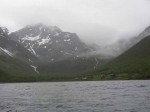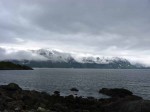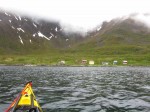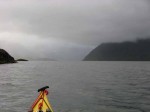Day 166. Nordbukt on Stjernoya to Bergsfjord
Posted by: James on June 15, 2009Distance 53km | Time 13hrs | Ascent 0m | Descent 0m
 Despite the heavy rain on the tent I managed to get up at 0600 and after packing everything into drybags and leaving them in the rain I packed the dripping tent. I eventually set off at 0800 with the estuary calm except for the splash of the large raindrops. A bunch of Goosander (Mergus merganser) swan in the tidal estuary, heads often immersed looking for small fish.
Despite the heavy rain on the tent I managed to get up at 0600 and after packing everything into drybags and leaving them in the rain I packed the dripping tent. I eventually set off at 0800 with the estuary calm except for the splash of the large raindrops. A bunch of Goosander (Mergus merganser) swan in the tidal estuary, heads often immersed looking for small fish.
The mainland on the other side of Stjernsund was just 5 km away, but it was lost in the mist and rain, as indeed were the high mountains above me. The lower slopes which I could see were very lush. Thick bunches of the succulent rockrose were now in yellow flower and a purple flower, either purple saxifrage or moss campion grew on the frequent rocky shelves. Despite the rain I could hear a lot of birdsong in the birch woods.
As I paddled along I heard some shrieking. When I looked round I saw two otters playing. They were just down wind 30 metres away, so I stopped paddling and drifted towards them. I don’t know if they were play fighting or courting but they were certainly excited emitting loud squeaks as they writhed on the surface. I got to within about 5 metres when they saw the yellow kayak and dived.
I paddled past the deep bay of Simavik with an old farm in the green pastures on the valley floor. The valley floor was cut by the raging white torrent off the swollen river. This farm was probably abandoned in the 1960s but the children or grandchildren probably maintained this ancestral connection as a leisure house now.
The next bay had a large industrial concern in it. It was an underground mine extracting nepheline syenite, a low silica feldspar type mineral, which is used in glass and ceramic manufacture. It was quite a surprise to see the large wharf with huge storage facilities to store this mineral on this otherwise empty and unspoilt island.
After the mine I decided to cross the sound while I could see across it and the wind was just a force three but against me. It was a slow but sure crossing. The advantage of the poor weather was that it made the other side seem much further than it was and I arrived much quicker that I expected.
I paused on the other side briefly and a redshank appeared on the rocks near me. Above were a couple of sea eagles. By the end of the day I would have seen at least 25 of these huge birds. One can only get an idea of the scale of them when you see a raven or large blackback gull harrying them.
 With the wind and tide against me as it had been all day as I made the final journey up the coast to Oksfjord at just over 4 km an hour. It was slow going. It was a shame the weather was obscuring the mountains here because this was now classic fjord country with narrow fjords cutting deep into high mountains. My map indicated that just on the other side of the peninsula from Oksfjord was a glacier which descended from these high craggy peaks and descended all the way to the sea calving icebergs in it.
With the wind and tide against me as it had been all day as I made the final journey up the coast to Oksfjord at just over 4 km an hour. It was slow going. It was a shame the weather was obscuring the mountains here because this was now classic fjord country with narrow fjords cutting deep into high mountains. My map indicated that just on the other side of the peninsula from Oksfjord was a glacier which descended from these high craggy peaks and descended all the way to the sea calving icebergs in it.
 I reached Oksfjord at around 1300. The town was a 3 km detour up the fjord. I knew if I went there I might get stuck, seduced by hamburgers and the thought of a hot shower, so I gave it a miss and went straight over to the simple life on the far west side where there was a tiny hamlet of 4 houses at Klubbnesvik and stopped here for lunch. There was someone on the beach.
I reached Oksfjord at around 1300. The town was a 3 km detour up the fjord. I knew if I went there I might get stuck, seduced by hamburgers and the thought of a hot shower, so I gave it a miss and went straight over to the simple life on the far west side where there was a tiny hamlet of 4 houses at Klubbnesvik and stopped here for lunch. There was someone on the beach.
I chatted with him. He owned one of the four houses. They were all in excellent condition and their barns and outhouses were well maintained. However these were also just summer houses and nobody lived here now and the barns had not seen animals for 50 years. The owners had moved across the fjord to Oksfjord for more modern occupations. Small holding and subsistence fishing here at Klubbnesvik had been abandoned in the 1960s in the days of their parents, who had moved from the hard life.
There was apparently some accommodation in Bergsfjord. If the weather in the exposed Lopphavet just round the corner was reasonably calm I would try and reach it. Here I could write in comfort and dry off the tent. It was about 30 km and the blatant wind and more negligible current would be against me. After a phone call to the ever helpful Bjorn of Bjornskajakks in Tromso about the rudder and some possible modifications I set off.
There were three main headlands to go round after Oksfjord to reach Nordre Bergsfjord. These took me out of the shelter of the sounds into the open ocean again. This ocean is called Lopphavet. The first thing I noticed was however the vegetation line in the sounds was just a metre or two above the high tide level while here the bare rock extended up a good 10 metres before vegetation to establish itself out of reach of the waves. It was not on the scale of Osthavet and Nordishavet where it was a good 30 metres but enough to show the weather here could be rough.
As I ventured into Lopphavet I hardly noticed a change. The swell was absent and the wind was still a force three and still against me. I went round the first peninsula and then crossed Nuvsfjorden to Sommarnes, a lonely and abandoned farm which was now derelict. In the bay in front of the farm was a salmon net trap. I could see a large dead salmon in the net just below the surface.
The salmon traps are constructed from a large mesh visible net the salmon can easily swim through. These are placed perpendicular to the shore for 200-300 metres where salmon pass en route to an estuary. The salmon can see this netting and will not swim through it but are diverted offshore into a V shaped monofilament net they cannot see and this is small mesh and ensnares them. I saw about 5 such set ups today along this coast.
The next and last fjord to cross was Ullsfjord. There was a hamlet here called Rokkenes on an extensive green and fertile plain from the shore to the foot of the mountains. It had no road to it and would be summer cabins only as the hamlet was certainly abandoned as a permanent settlement some 50 years ago also.
As I rounded the last peninsula, and the steep mountain of Stauren I saw many more sea eagles. At one stage there were 4 in the air around me. I could see one return to its eerie in the crags on the mountain. These birds were massive, bigger than a Golden Eagle, but without the same pride and nobility.
 I had hoped the wind would be behind me for the final 12 km down Nordre Bergsfjord to the village of Bergsfjord, but it was against me. There was also the odd rain shower so the 1000 metre mountains were obscured. Across the fjord was the dark, lonely and mysterious island of Silda, which I am sure, had no permanent settlement.
I had hoped the wind would be behind me for the final 12 km down Nordre Bergsfjord to the village of Bergsfjord, but it was against me. There was also the odd rain shower so the 1000 metre mountains were obscured. Across the fjord was the dark, lonely and mysterious island of Silda, which I am sure, had no permanent settlement.
I eventually rounded a point and entered the bay where Bergsfjord lay. I asked a fisherman about accommodation and he pointed me to a nearby house. The house owner appeared. He had just returned from a trout fishing trip to Scotland and knew the family whom I stayed with at Hakkstabben a couple of days ago well. He had a lovely apartment and owned the shop also. He was an interesting character. After showing me the apartment he opened the shop for me.
With the kayak on a beach nearby I unpacked the minimum, ate the just purchased supper from the shop and then had a warming and salt rinsing shower before crashing out in soft cotton. The forecast tomorrow was a force five from the west and therefore against me, so I decided to have a free day. I looked forward to explore this charming village in a bay of sandy islands surrounded by dark mountains.
It had been a really good day despite the weather. Indeed the weather made the views very atmospheric. Despite the head wind I had covered a respectable distance also.